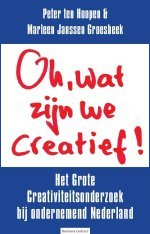






|

How to create creative organisations
Effective four-step approach:
-
Diagnostics - Chart the Organisation's Creativity
We plot the organisation's Creativity Index using our
Creative Culture Survey (CCS), a fine-grained look at the factors promoting and inhibiting creativity and innovation in the team, department or entire organisation. Low cost, very effective in opening up discussion and forcing reflection.
 Either in parallel or separately we use our Innovation Roles Model (IRM), which identifies eight different roles people play in a field outlined by the axes of Creativity and Risk-Readiness. Builds on work by Belbin, Byrd and Lockwood Brown. All our work on innovation is linked to leadership. Either in parallel or separately we use our Innovation Roles Model (IRM), which identifies eight different roles people play in a field outlined by the axes of Creativity and Risk-Readiness. Builds on work by Belbin, Byrd and Lockwood Brown. All our work on innovation is linked to leadership.
- Validation - Analyse and Discuss the Outcome
To be accepted, results need to be analysed and validated (and where necessary fine-tuned) in workshops - highly interactive. Is this really who we are? Are we happy with it? If not, how do we change?
- Change - Breakthrough Initiatives
Appoint change teams to come up with initiatives that provide real breakthroughs in terms of the organisation's or the group's attitude towards creativity. What do we need to do to open up our minds? How do we best apply our energy? And who is ready to take ownership for agreed changes? Who shows real leadership? Uses Innovation Roles Model to create strong teams of people who understand one another's role, and become mutually supportive.
- Root - 'Keep the Change'
Our idea is to help organisations help themselves. We just provide the framework, the tools, the spark, the facilitation. Once that is done, we get out of your way. The change is yours to keep. And to maintain. Lasting change is achieved through our Values to Performance Program - highly engaging workshops in which participants jointly agree to commit themselves to behaviours that they themselves support. Creates awarenes of creative potential, awareness of one's own limiting factors and a sense that these can be overcome, particularly by working with others. Also sets out guidelines that prevent backsliding into non-productive, creativity limiting behaviour.
|
|
An in-depth 2008 study in the Netherlands by Peter ten Hoopen and economist Marleen Janssen Groesbeek on the factors that stimulate and hinder creativity in organisations, sheds light on what are still the most mysterious processes in the world of business: creativity and innovation. Based on web survey supported by leading financial daily with 850 participants responding to 84 statements and 5 open questions.
The study finds that creativity is best served by openness towards the ideas of others, and an environment of trust. Also reveals a poignant paradox: businesses are clamoring for more creativity, while doing everything they can to kill it. Many appear to be permeated with fear - a real creativity killer, because in fear people do what they know will work and avoid experiment - and beset with ego issues like "I listen to the ideas of others, but in the end will push my own"
Same survey in English is available at www.creativityresearch.net. Participation for individuals is free. Roving Star clients obtain detailed assessments with rich statistics that chart which attitudes in their organisation need ajustment, and which need strengthening. Used to lift the creative spirit in organisations.
 Oh, wat zijn we creatief!
Oh, wat zijn we creatief!
'Oh, how creative we are!'
Peter ten Hoopen & Marleen Janssen Groesbeek
Business Contact, Amsterdam August 2008.
ISBN: 978 9047001171

|
We speak from experience
Roving Star's founder is the author of a dozen books, seven of them literary fiction, and co-founded a successful advertising agency in Amsterdam. In that capacity he has created award-winning work for Saab, KPMG, KLM, IBM, ABN-AMRO, NRC, Sony, and several other leading firms.
|
| | | |








